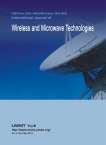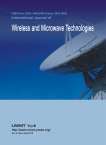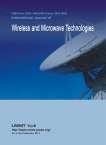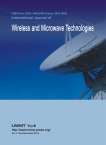Статьи журнала - International Journal of Wireless and Microwave Technologies
Все статьи: 454
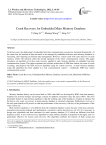
Crash Recovery for Embedded Main Memory Database
Статья научная
In the last years, the deployment of embedded real-time communication systems has increased dramatically. At the same time, the amount of data that needs to be managed by embedded real-time main memory databases is increasing, thus requiring an efficient data management. However, system crash will cause data loss in main memory, which will seriously affect the normal operation of the entire communication system. This paper introduces an algorithm of system crash recovery applied in main memory database of embedded real-time communication system. This paper expatiates the software architecture of SDR base station, the cause of crash occurring, and proposes the flash recovery algorithm using for system recovery. A main memory database using this algorithm has been applied in a real communication system——multimode SDR base station communication system.
Бесплатно
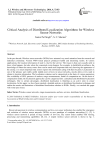
Critical Analysis of Distributed Localization Algorithms for Wireless Sensor Networks
Статья научная
In the past decade, Wireless sensor networks (WSNs) have attracted very much attention from the research and industrial community. Various WSN based projects produced fruitful and interesting results. In various applications, the location information of node is vital for the service. The reason is that users usually need to know what happens, but also where the concerned events happen. For example, in battlefield surveillance, the knowledge of where the enemy comes from can be much more important than only knowing the appearance of the enemy, it is much important that sensors reports the information along with their location. Localization is one of the primary and widely useful middle-ware services in sensor networks, mostly allows every node to obtain its location information. The localization schemes can be categorized on the basis of various parameters like availability of GPS, presence of anchors, range measurements, model of computation etc. On the basis of computation model, the localization approaches can be categorized into: centralized and distributed localization techniques. Due to certain advantages, distributed localization is flattering as an active stem in sensor localization. In this paper, we have been reported a detailed analysis on distributed localization techniques and outline the merits and limitations of distributed localization schemes in WSNs. Finally, we conclude the paper with some open issues.
Бесплатно
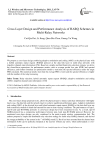
Cross Layer Design and Performance Analysis of HARQ Schemes in Multi-Relay Networks
Статья научная
We propose a cross-layer design combining adaptive modulation and coding (AMC) at the physical layer with a hybrid automatic repeat request (HARQ) protocol at the data link layer in multi-relay networks with imperfect channel state information (CSI). Based on a simple and distributed relay selection strategy, we derive the closed-form expressions for performance metrics such as average packet loss rate (PER) and spectral efficiency; and further formulate an optimization model to maximize the spectral efficiency under the target PER constraint. The numerical results show that the average PER is lower and the spectral efficiency is higher with the number of the relay increasing.
Бесплатно
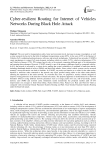
Cyber-resilient Routing for Internet of Vehicles Networks During Black Hole Attack
Статья научная
The ever need for transportation safety, faster and convenient travel, decrease in energy consumption, as well as inter-connectivity has led to the field of intelligent transportation system (ITS). At the core of ITS is the Internet of Vehicles (IoV) combining hardware/sensors, software, and network technologies. Vehicular ad hoc networks (VANETs) create mechanisms to connect IoV main elements, including vehicle-to-vehicle (V2V), vehicle-to-infrastructure (V2I), and Vehicle-to-Sensors (V2S). ITS systems heavily rely on its network connecting different parts of its infrastructure and ensuring data exchanges. However, VANET security is one of the primary challenges faced by connected vehicles. In IoV, the network is accessed by a variety device making the system vulnerable to a multitude of malicious attacks, including distributed denial-of-service (DDoS) and black hole attacks. Since critical vehicle systems can be accessed remotely, successful attacks can lead to fatalities. In VANET, any node can function as a router for the other nodes, therefore a malicious node connected to the network may inject spoofed routing tables to the other nodes thereby affecting the operation of the entire network. To overcome this issue, we proposed a security scheme designed to improve routing protocols in the detection of black hole attack. The proposed approach is demonstrated on a Network Simulator (NS3.27) using different network parameters such as average packet loss rate, end-to-end delay, packet delivery ratio (PDR) and network yield. Simulation results demonstrate the proposed method adds 10-15% improvement (on average) in End-to-End Delay, Packet Delivery Rate, Packet Loss Rate and Network Yield as compared with conventional Greedy Parameter Stateless Routing and Path Aware Greedy Parameter Stateless Routing under the black hole attack.
Бесплатно
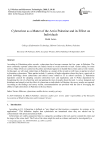
Cybercrime as a matter of the art in Palestine and its effect on individuals
Статья научная
According to Palestinian police records, cybercrimes have become common last few years in Palestine. The most commonly reported cybercrimes are mainly based on social networks to hack victims asking for some service. Many efforts are carried out by police and related agencies to handle these crimes and save the victims. In this paper, we will study cybercrimes in Palestine as a matter of the art and we will focus on parties involved in thwarting cybercrimes. These parties include: 1) ministry of higher education where they have a great role to afford knowledge about cybercrimes and ethical issues related to IT in school curricula. 2) Palestinian legislative council for adopting concrete cybercrime laws and regulations. and 3) Police department by broadening the role of cybercrime unit and gaining the trust of people about that unit. A survey designed and distributes and aimed to test the effect of cybercrime on individuals in Palestine, the survey results are reported. According to the findings and survey results, recommendations are provided with the aim of leveraging the ability to fight cybercrimes in Palestine in the near future.
Бесплатно
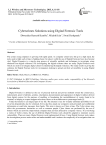
Cybercrimes Solutions using Digital Forensic Tools
Статья научная
The crimes using computers is growing with rapid speed. As computer crimes have hit up to a high mark, the tools used to fight such crimes is budding faster. In today's world the use of Digital Forensics have also become vital. Digital Forensics is a step-by-step process of scientific methods and techniques to investigate crime obtained from digital evidences. For investigating the digital evidence there are many Digital Forensic tools which are used to investigate digital crimes by identifying the digital evidences. The study results in giving the solutions for Digital Forensic tools for investigators looking to spread out their serviceability in using Digital Forensic tools.
Бесплатно
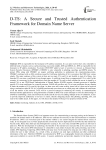
D-TS: A Secure and Trusted Authentication Framework for Domain Name Server
Статья научная
DNS is responsible for the hostname to IP address translation. It is an open resolver that's why vulnerable to different kinds of attacks such as cache poisoning, man-in-the-middle, DOS and DDOS, etc. DNS is responsible for the hostname to IP address translation. To protect DNS IETF added a layer of security to it known as Domain Name System Security Extensions (DNSSEC). DNSSEC is also vulnerable to phishing, spoofing, and MITM attacks. To protect DNS, along with DNSSEC we require certifying authorities to authenticate the communicating parties. DNSSEC combined with an SSL certificate issued by Certifying Authorities (CA's) can protect the DNS from various attacks. The main weakness of this system is there are too many CA's and It is not feasible to trust all of them. Any breached CA can issue a certificate for any domain name. A certificate issued from a compromised CA's is valid. In this scenario, it is necessary for the organization to limit the number of CAs and to check whether the server is signed by a trusted CA's or not. DNS Based Authentication of Named Entities (DANE) permits a domain possessor to stipulate specific CA's issue certificates for a specific resource. DANE will not allow any CA to issue certificates for any domain. It limits the number of CA's used by the client. As there were still some security issues left in it that can be resolved using a mechanism called D-TS. It is a DANE-based trusted server that acts as a third party and validates the certificates of all the entities of the network. D-TS will be a proof-of-concept for enhancing the security in communications between Internet applications by using information available in DNS. The system attempts to solve the shortcomings of DANE by establishing a trust zone between the clients and the services. By adding multiple levels of validations, it aims to provide improved authenticity of services to clients, thereby mitigating attacks like phishing, Spoofing, Dos, and man-in-the-middle attack. In this paper, we will discuss the detailed working of our proposed solution D-TS.
Бесплатно
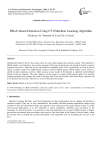
DDoS attack detection using C5.0 machine learning algorithm
Статья научная
Distributed Denial of Service has always been an issue while dealing with network security. The potential of DDoS attacks is not limited by any security measures. This type of attack does not attempt to breach a security perimeter but aims to make the service unavailable to legitimate users. This is particularly an issue in private clouds as public clouds have sophisticated systems to prevent DDoS attacks. DDoS attacks can be used as a shield for other malicious activities. Open resource access model of the Internet is exploited by Distributed Denial of Service attackers. The main objective of this paper is to detect DDoS attacks using C5.0 machine learning algorithm and compare the results with other state of the art classifiers like Naïve Bayes classifier and C4.5 decision tree classifier. The focus is on an offline detection model.
Бесплатно
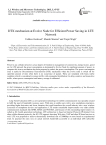
DTX mechanism at Evolve Node for Efficient Power Saving in LTE Network
Статья научная
Power in any cellular network is a key degree of freedom in management of connectivity, energy factors, speed etc. In LTE network the power consumption is dominated by Evolve Node by significant amount of power, to compute this issue a mechanism has been proposed to reduce the power consumption. The power consumption issue is tackle by Discontinuous Transmission (DTX) mechanism where the evolve node is switch off for specified amount of time when there is no occurrence of packet. These are simulated with busty traffic condition which is considered to poison traffic with exponential distribution for delay sensitive and insensitive traffic, where power consumption and latency average is calibrated.
Бесплатно
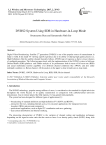
DVBS2 System Using SDR in Hardware-in-Loop Mode
Статья научная
Digital Video Broadcasting- Satellite 2nd generation (DVBS2) is one of the popular source of entertainment in today's world. It has made TV viewing superb experience due to its ability of sharing high quality picture (i.e. High Definition). But the satellite channel basically follows AWGN type of response as there is lesser chances of multipath generation. The following paper deals with the implementation of the DVBS2 system in Software Defined Radio (SDR) platform and further analysis of its performance both in terms of bit error rate (BER) and actual multimedia transfer capability over different channel conditions like AWGN, and also under multipath condition i.e. Rician channel. All the analysis in the paper is done in hardware-in-loop mode.
Бесплатно
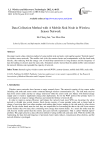
Data Collection Method with A Mobile Sink Node in Wireless Sensor Network
Статья научная
This paper resent a data collection method of using mobile sink and static sink together against “thermal region” in wireless sensor network. The mobile sink visits the remote-cluster and communicates with the head node directly, thus reducing both the energy cost of multi-hop transmission in long distance and the frequency of data forwarding in clusters near the static sink. Simulation results showed that the added mobile sink extended the network lifetime and expanded the capacity of network.
Бесплатно
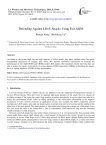
Defending Against LDoS Attacks Using Fair AQM
Статья научная
According to the instant high rate and high intensity of LDoS attacks, this paper explores using fair queue management mechanism to mitigate their effect. We perform simulation experiments to evaluate the performance of fair AQM FRED and CHOKe under LDoS attacks. The simulation results show that they are able to reduce the impact of the attacks in various degrees. FRED outperforms CHOKe in throttling the attacks, but it is slightly inferior to CHOKe in time performance.
Бесплатно
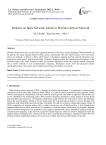
Defense on Split-Network Attack in Wireless Sensor Network
Статья научная
Wireless Sensor Network is an open self-organized network, which faces serious challenge. Whole network can be split up into many separate subnets which cannot communicate with each other because some vital sensor nodes are attacked. A defense scheme which based on frequency hopping and fast network integration was proposed to react against split-network attack. Frequency hopping makes the communication frequency of the network escape from attack frequency while fast network integration makes the separate subnets reintegrate into a whole network in new communication frequency. Simulation results show the proposed scheme significantly reduces the success rate of attack and increases the lifetime of network.
Бесплатно
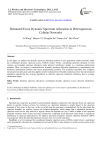
Demand-Driven Dynamic Spectrum Allocation in Heterogeneous Cellular Networks
Статья научная
In this paper, we address the dynamic spectrum allocation problem in next generation cellular networks under the coordinated dynamic spectrum access (CDSA) model. Firstly, considering spectrum demands of base stations, we formulate spectrum allocation under physical interference models as a nonlinear optimization problem. Then, we propose a demand-driven dynamic spectrum allocation algorithm by transforming this nonlinear optimization problem into linear programming problem. The proposed algorithm first computes initial spectrum allocation and then applies iterative enhancement. Detailed simulations show that the proposed algorithm outperforms the existing algorithms in effective spectrum utilization efficiency and in average satisfaction degree.
Бесплатно
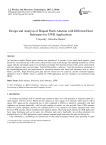
Design and Analysis of Biquad Patch Antenna with Different Hard Substrates for UWB Applications
Статья научная
An innovative double Biquad patch antenna was introduced. It consists of two quad patch together. good directivity was achieved due to the corner reflector effect used in this design. The radiating elements are of four square with the side length equal to 1/4 mid band wavelength. The theoretical beam width can be varied widely with the reflection plane size and shape. Vertical Polarization is achieved from the position of orientation of the biquad.Biquad patch was implemented in microstrip antenna with three hard substrates such as Arlon, Neltec, and Fr4, High directivity,good gain and low return loss was achieved, and the resonant frequency obtained is from 5-10GHz, which is suitable for UWB application and the simulation was performed using HFSS.
Бесплатно
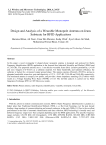
Design and Analysis of a Wearable Monopole Antenna on Jeans Substrate for RFID Applications
Статья научная
In this paper a novel rectangular C-shaped planar monopole antenna is designed and analyzed for Radio Frequency Identification (RFID) application in the licensed-free Industrial Scientific and Medical (ISM) band of 2.45 GHz. The proposed antenna uses a 1 mm thicker wearable Jeans fabric {relative permittivity, εr=1.68 and Loss Tangent of δ=0.025} as a substrate material. For better bandwidth, and radiation efficiency the substrate is backed by a truncated copper ground plane. The antenna operate efficiently (92.85%), giving an adequate bandwidth, return-loss, gain and directivity of 12 %, -35.57 dB, 3.144 dB and 3.465 dBi, respectively. The nominated antenna is compact, low profile, and provides a better impedance matching (50.25 ohms) which results in a Voltage Standing Wave Ratio (VSWR) of 1.03. The far-field analysis is carried out via Finite Integration Technique (FIT) in CST Microwave studio.
Бесплатно

